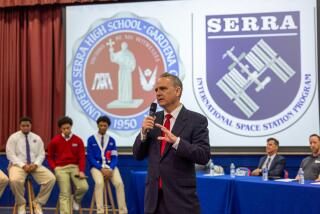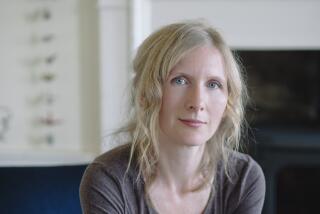Q&A: MacArthur winner Sarah Stewart explores how random collisions shaped our planet and solar system
- Share via
As a young Trekkie, Sarah Stewart knew she wanted to study distant worlds. But as a kid, she never imagined where that interest would lead.
“Nobody as a little child thinks, I’m going to grow up and have a lab full of cannons,” said Stewart, a planetary scientist who was awarded a “genius” fellowship from the MacArthur Foundation on Thursday.
Today she runs the Shock Compression Lab at UC Davis, one of the few places in the country with guns powerful enough to shoot a projectile at speeds in excess of 4 miles per second.
Experiments in her lab move so quickly that they are generally over by the time you hear the sound of the impact, she said. And the shots are so powerful that in most cases, all that remains of the target is vapor.
For Stewart, the purpose of all this high-impact shooting is to better understand how the Earth and other planets formed in the chaos of the early solar system.

Her discoveries have helped scientists glean more information from impact craters across the solar system. They’ve also led to an entirely new theory of the moon’s origins that includes a new astrophysical object called a synestia.
“With the ever-growing number of exoplanet discoveries and missions to other planets, Stewart will play a critical role in providing a firmer and more comprehensive basis for understanding planet formation,” the MacArthur Foundation said in announcing the award, which comes with a $625,000 stipend paid out over five years.
Stewart spoke with The Times about what inspires her work, the new object she described, and what she plans to explore next.
Congratulations on the award! What was it like hearing that news?
They called my office during the day. Usually I don’t pick up when I don’t recognize the number, but it was from D.C. so I did. They introduced themselves as being from the MacArthur Foundation. Once they say that you know what’s coming next. I think I squealed, and then my hands didn’t stop shaking for two hours.
What kind of work goes on at the Shock Compression Lab?
It’s a beautiful facility. We have two gas compression cannons that use compressed gases like hydrogen and helium to accelerate projectiles. This allows us to study how rocks and minerals behave during impact events.
How does that help you understand the way planets form?
We take the data we gather and plug it into computer simulations of natural collision events. Then we use those models to interpret what we see in the solar system and reconstruct the history of growing planets.
Is there a single question that drives your work?
Understanding the Earth and what makes it special — why is it habitable when Mars and Venus are not? The Goldilocks question drives a lot of us in planetary science.
This year your group published a new model for the origin of the moon. Why did you need a new theory?
The models we had for lunar creation didn’t predict the moon’s chemistry. The original models suggested the moon would look like the Mars-sized object that hit us, but the Earth and the moon are identical twins.
What do you think happened?
Our new model for the origin of the moon is a giant impact with a large object that leaves the Earth spinning faster than in previous models. Those models had the Earth spinning fast enough that a day was over in 5 hours. Our new model suggests a day lasted only 2.5 or 3 hours.
When there’s this much energy, the impact makes a special planetary object.
A synestia?
Yes.
Picture the Earth. Then imagine heating it up so much it has a vapor atmosphere. Now it is spinning so quickly that the whole thing cannot rotate all together and instead spreads out to form a disk around the original planet. When you do that, you’ve made a new planetary object that we call a synestia.
How does the moon fit into this scenario?
We propose that the moon was surrounded by the vapor of the Earth when it formed. So it actually formed from the Earth when the Earth was vaporized.
Wow, that’s crazy.
It really is mind-blowing, because we think of the Earth as so solid. But at that time it was more like a gas giant, like Jupiter. And if you were watching it, the Earth would be glowing. It would actually be too bright to look at.
What do your colleagues make of this theory?
(Laughs) I would say it is still quite controversial. It is quite new. It’s a very different system. We’ve made a new object, and a new environment to grow the moon in.
In science, the standard response to anything different is a healthy dose of skepticism. That doesn’t reflect on the merit of the work; it’s the process of science — to demand that someone prove it to you.
What are you most excited to be working on now?
We are collaborating with scientists at the U.S. Department of Energy to get to higher temperatures and pressures than we can get to in my lab. One of the coolest things we are doing now is taking the minerals we see in the Earth’s mantle and taking them to two to three times the pressure at the center of the Earth and watching them vaporize.
What is really new technologically is that we can do experiments that reach all the temperatures of growing planets. That is the new excitement in the field.
You do weeks of preparation before running an experiment. How do you feel when your results don’t turn out as expected?
What I tell my students is our imaginations do not capture all of nature. Nature has done many, many more things than we can imagine, and we are playing catch-up just trying to consider all the possibilities.
This interview has been edited for length and clarity.
MORE IN SCIENCE







